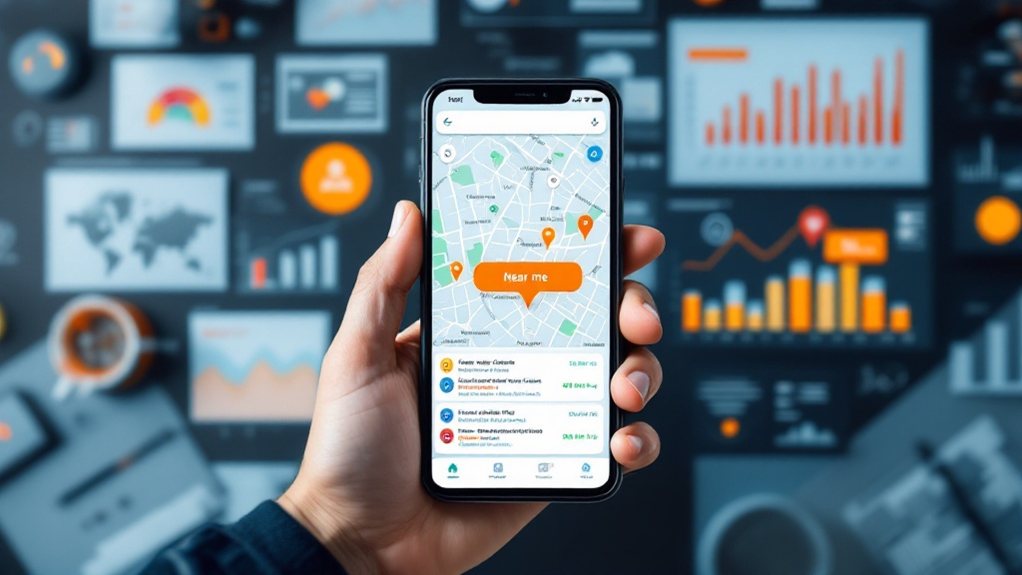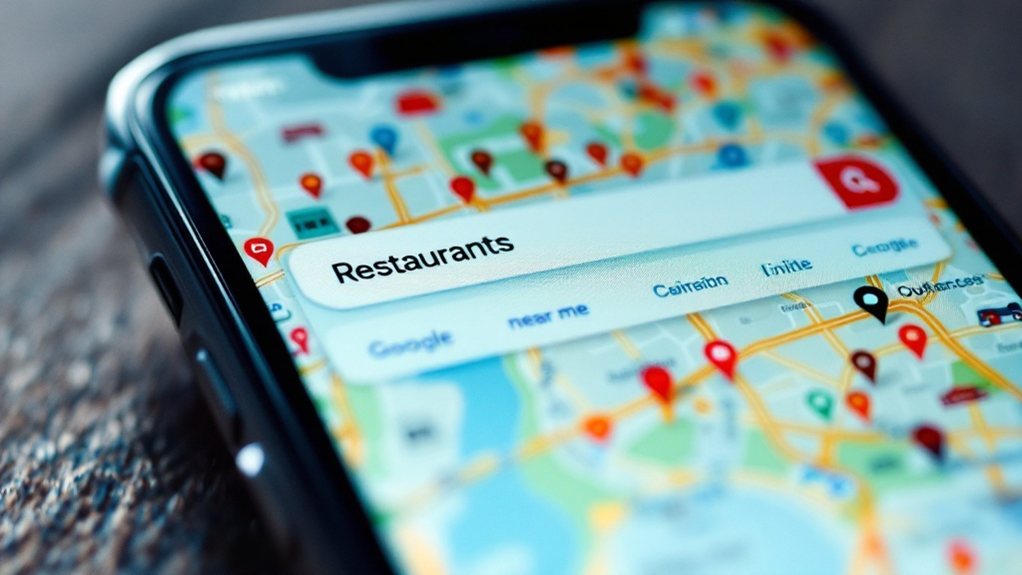'Near me' searches are mobile-driven queries that reflect your urgent need for local, immediate solutions. Search engines use your location to provide relevant, nearby results. These searches are incredibly popular and indicate strong purchase intent – nearly 30% lead to sales. Optimizing your local presence is crucial for visibility and driving foot traffic. There's more to learn about how 'near me' searches can benefit your business.
Definition and Usage of Near Me Searches

Near me searches are a common feature of modern online queries. They're typically performed on mobile devices and include phrases like "near me" to find nearby businesses or services. These searches are often urgent, with users looking for immediate solutions close by. Search engines leverage GPS data to provide location-based results tailored to the user's current whereabouts. Users commonly combine "near me" with terms like "open now" to find available options. This type of search is increasingly frequent as mobile device usage continues to grow. Examples include queries for coffee shops, gas stations, or restaurants in the user's vicinity.
Popularity and Search Platforms

The surge in "near me" searches is undeniable, with a staggering 500% increase in recent years. These searches predominantly happen on Google, reflecting the platform's dominance in local search capabilities. Interestingly, 84% of these searches are conducted on mobile devices, highlighting the growing importance of optimizing for mobile experiences. Local SEO is crucial for businesses to capitalize on this trend and connect with nearby customers.
Significant Growth Rate
Witnessing the rapid growth of "near me" searches in recent years, you see a clear trend towards increased local search behavior among consumers. Reports indicate a staggering 500% increase, showcasing the growing popularity of these searches. The preference for "near me" searches highlights consumers' desire for quick, nearby solutions, making this trend increasingly important for businesses to capitalize on through local SEO optimization. Reflecting this, most "near me" queries occur on Google, which provides critical local business listings. This shift in platform utilization is significant, as Google surpasses traditional platforms like Yelp.
Mobile Device Dominance
Over half of all organic search engine visits in the United States are now conducted on mobile devices. In fact, nearly 60% of all online searches happen on smartphones and tablets, reaching up to 72% in some sectors. Mobile devices have become the dominant platform for search, with Google dominating the mobile search market with a 95.32% share, making it the leading platform. This mobile-first shift has prompted Google's transition to mobile-first indexing, emphasizing the importance of mobile optimization for search visibility.
| Mobile Search Platforms | Market Share |
|---|---|
| 95.32% | |
| Others | 4.68% |
The rise of mobile searches, especially "near me" queries, has significant implications for local businesses seeking to capitalize on high-intent customers.
Prevalent on Google
Reflecting the mobile-first shift, Google dominates the "near me" search landscape, accounting for the vast majority of these queries. Most "near me" searches occur on Google, with the platform's Local Pack (3-Pack) capturing 44% of all clicks. Users have high intent when searching "near me," often seeking immediate solutions, and this search type has largely replaced traditional methods like zip codes. Optimizing for "near me" is crucial, as it can significantly boost local SEO efforts, with 68% of users preferring local 3-pack results over organic or paid listings. Businesses must ensure their Google My Business profiles are accurate and optimized to capitalize on this high-intent search behavior. The rise of voice-activated devices has further contributed to the growing popularity of "near me" searches.
Immediate Results and Local Intent

Why are "near me" searches often composed with keywords like "near me," "closest," and "open"? These searches reflect users' urgent needs and local intent – they're ready to take immediate action, such as visiting a nearby business. Search engines prioritize results based on proximity and relevance, and users frequently convert these searches into offline actions within a day.
Businesses with accurate and updated information are more likely to rank higher in near me searches. Here are 4 key points about "near me" searches:
- Location services must be enabled to provide accurate, location-based results.
- Search engines display businesses closest to the user, prioritizing proximity.
- Relevant business information, reviews, and ratings are crucial for better rankings.
- Users often combine "near me" with terms like "open now" for more specific results.
Business Impact and SEO Importance
Optimizing for 'near me' searches can give your business a competitive edge, especially in saturated markets. Appearing in the local 3-pack enhances your visibility and drives more clicks, ultimately boosting local sales and customer engagement. Effective SEO strategies are key to attracting ready-to-buy customers and improving your online reputation.
Boosting Local Visibility
The ability to boost local visibility is paramount for businesses with a physical presence. "Near me" searches reflect high-intent consumers actively seeking your products or services nearby. To optimize your local visibility and capitalize on this opportunity:
- Claim and optimize your Google My Business profile, providing accurate, up-to-date information to build trust and credibility.
- Incorporate location-specific keywords throughout your website content, targeting the areas you serve.
- Encourage and respond to customer reviews, as positive feedback can significantly impact your local search rankings.
- Ensure your website is mobile-friendly, as the majority of "near me" searches occur on smartphones.
- Prioritize local content creation to engage the community and further boost your local SEO.
Driving Conversion Rates
"Near me" searches demonstrate a strong intent to find nearby services, with 28% leading to a purchase and 78% resulting in an offline transaction. This highlights their significant business impact. Over 1.5 billion near me searches per month occur, further emphasizing the importance of these searches. Furthermore, 84% of these searches are conducted on mobile devices, emphasizing the role of mobile SEO. Improving your business's online presence, including reviews and schema markup, can boost trust and visibility, driving more conversions.
| Factors | Impacts |
|---|---|
| Immediate Needs Fulfillment | Higher Conversion Rates |
| Trust and Profiling | Increased Business Views |
| Voice Search Influence | Improved Local Visibility |
Optimizing your Google My Business profile, creating localized content, and ensuring a mobile-friendly website are essential SEO strategies to capitalize on this growing trend.
Marketing Strategies for Near Me Searches
Crafting a robust local search engine optimization (SEO) strategy is paramount for businesses aiming to capitalize on "near me" searches. Optimizing your Google My Business (GMB) profile, using location-based keywords, maintaining up-to-date business hours, and encouraging positive reviews are crucial steps. Additionally:
- Create location-specific pages to enhance local visibility.
- Leverage schema markup and embedded maps to provide users with a seamless experience.
- Identify relevant "near me" keywords and apply them across your digital presence.
- Monitor local search rankings and engage with customer reviews to refine your approach.
- Implement evolving near me SEO strategies to maintain a competitive edge as the future of near me SEO involves voice search optimization, hyperlocal content, and personalization.
Implementing these strategies will help you reach and convert customers searching for businesses like yours in their immediate vicinity.
Growth Trends and Mobile Dominance
Alongside the critical local SEO strategies we discussed, the surging growth and mobile dominance of "near me" searches warrant further examination. The data shows these searches have grown exponentially, outpacing comparable queries by 150%. The rise is fueled by the shift to mobile devices, which account for the majority of "near me" searches. Mobile's intent-driven nature and the influence of voice search have amplified this trend. Businesses must recognize that these local, mobile-first queries often lead to immediate action, from store visits to purchases. Optimizing for this mobile-centric behavior is essential for capturing these high-intent consumers.
Importance for Local Businesses
"Optimizing for 'near me' searches can greatly boost your local visibility. These searches indicate high conversion rates, with 28% leading to purchases and 76% resulting in visits within a day. By aligning your marketing efforts with this trend, you can gain a competitive edge and drive more sales for your local business."
Boost Local Visibility
The visibility of your local business is paramount when it comes to "near me" searches. Optimizing for these queries can enhance your online presence, driving more foot traffic and customer engagement. Here are four key ways to boost your local visibility:
- Claim and optimize your Google My Business profile to ensure accurate location data and positive reviews.
- Incorporate relevant local keywords into your website content to improve search relevance.
- Leverage social media to showcase your products, services, and community involvement.
- Encourage satisfied customers to leave online reviews, which can positively impact your search rankings.
Conversion Rate Impact
Because local searches drive significant consumer engagement, with 46% of all Google searches seeking local information, the conversion rate impact is crucial for local businesses. These searches lead to immediate action, with 88% of consumers visiting or calling a store within a day. Moreover, 80% of local searches convert into sales or visits, and 18% result in a sale within one day. Businesses that optimize for "near me" searches can expect increased foot traffic and sales, as these searches indicate high buying intent. Maintaining accurate business listings and leveraging positive reviews are key to capitalizing on this trend.
Factors Influencing Near Me Search Ranking
Three primary factors influence "near me" search rankings: relevance, distance, and prominence. Relevance involves how well your business matches the search query, while distance prioritizes businesses close to the searcher. Prominence is determined by your online visibility, reviews, and authority.
To improve your "near me" search rankings, consider these strategies:
- Use exact locations in title tags and headings to enhance local relevance.
- Balance location mentions with natural language to avoid keyword stuffing.
- Focus on building a strong, trustworthy brand image to increase prominence.
- Leverage location-specific content to improve user engagement and search visibility.
Optimizing Google My Business Profiles
Optimizing your Google My Business profile is crucial for enhancing your visibility in local search results. Claim and verify your profile, ensuring accurate business details, complete listing information, and relevant categories. Upload eye-catching media, create engaging content, and actively manage customer reviews and queries. Leverage specialty features tailored to your industry, and align your website's SEO with your Google My Business optimization efforts. Regularly track performance and stay updated on evolving best practices to ensure your profile remains competitive. By prioritizing these strategies, you can effectively reach nearby customers and boost your online presence.
Leveraging Hyperlocal Advertising
As a business owner, you can leverage the power of hyperlocal advertising to gain a competitive edge in your local market. By creating tailored campaigns that target a specific geographic area, you can build trust and loyalty among your local customers. Here are four ways to effectively leverage hyperlocal advertising:
- Customize your messaging to reflect local preferences and needs.
- Utilize location-based marketing to deliver relevant ads to users near your business.
- Analyze localized data to make real-time adjustments and optimize your campaigns.
- Replicate successful hyperlocal campaigns across multiple locations to maximize your reach.
